While the scooter rental business has cooled off, electric scooters are here to stay. Increasingly popular as personal transportation, these micromobility machines with electric motors and straightforward controls are a great solution for last-mile transportation (getting home from the train or bus, for instance). They’re nimble enough to transport you quickly, and you won’t break a sweat while riding to work. And since they’re much smaller and lighter than most bikes, they’re easy to carry up stairs, stow under a desk, or hide away in a closet.
We checked out 7 popular models — and spent some time riding a Lime rental scooter — determining their range and speed, their overall feel and ease-of-use over a variety of terrains and surfaces, and getting a sense of how we could integrate them into our daily routine. After all that, we found a couple of great scooters that can improve your commute, no matter what your budget.
The best electric scooter overall
The Segway Ninebot Max strikes the best balance between power, range, and compactness of any electric scooter we tested. It’s simple to learn and use, and the powerful motor and comfortable ride easily tackled every route.
The best budget electric scooter
At around half the price of our top pick, this Segway scooter has less power and range, but doesn’t compromise on build or ride quality and offers the same straightforward, easy to use controls as the rest of the Ninebot lineup.
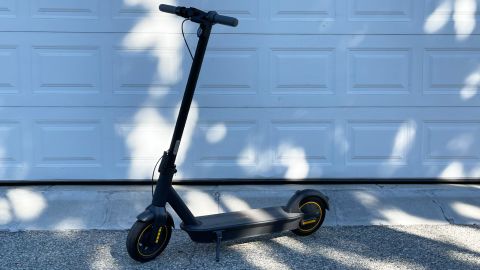
Striking a better balance between power, range, and compact size than any other scooter we tested, the Segway Ninebot Max was our favorite electric scooter overall. Riding the Segway Ninebot Max is about as easy as it gets, and we were ready to hit the streets after about a minute of experimenting. The thumb throttle is responsive but not too jerky, and the mechanical handbrake allows for confident, gradual control of your speed, as well as more sudden stops if needed. The display — a vertical screen in the center of the handlebars — clearly shows the current speed, speed setting, and battery level. A single button is used to power on the unit, toggle through the three speed settings, and activate the LED headlight. It’s as easy as they come.
The 350W of power supplied by the motor allowed me to easily hit speeds of up to 20 MPH on the flats, and really impressed me with how well it handled the incline portions of my testing route. Unlike similar scooters that struggled with hills, the Segway Ninebot Max seemed to relish the challenge, and was able to maintain a solid 14 MPH on the steepest grade we climbed during testing, second only to the much larger Apollo City Pro. Thanks to the impressive battery capacity, this scooter also seemed to have a never-ending range, making it 21.4 miles before finally depleting its battery. The overall ride itself was smooth and comfortable too, and the 10-inch tires (it ships with traditional tires that use inner tubes) handled small bumps and cracks without too much discomfort to the rider. Some of the competition ships with solid rubber tires which aren’t really suited to riding any distance.
The Segway mobile app was reliable in our testing, while the apps from other brands felt like they were still working the bugs out. The app provides a battery percentage level — very convenient when charging — and provides a map of your entire route, using shades of light green to dark red to indicate your speed in different areas. Plus, you can lock the scooter with the touch of a button. (This “lock” simply prevents it from accelerating and sounds a constant beep if anyone tries to push it away. Not exactly 100% effective but could definitely discourage a would-be thief walking by).
Just like the other Segway Ninebot scooters in our testing, the Ninebot Max had impressive build quality and intentional, well-thought-out overall design. It’s clear that Segway has been doing this a long time, unlike other scooter brands that felt like they were still working out design and functionality issues.
The only real drawback to the Segway Ninebot Max (aside from the price, and assuming it is within your budget) is its weight. At 41.2 pounds it’s not the easiest to carry around, but it’s important to remember that this extra battery weight is what allows for its long range, and that’s always going to be a trade-off. If you want a comfortable ride and don’t want to constantly worry about your battery level, this could be the perfect option.
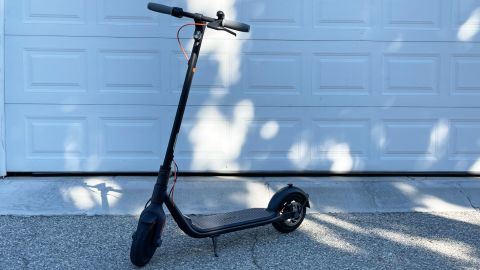
The scaled-down sibling of the Segway Ninebot Max, the Segway Ninebot F30 features the same high-quality construction and straightforward controls of our top pick — though with a bit less power and range — at a much lower price. Plus, you still get all the perks that come with the Segway mobile app, like route maps, Bluetooth locking capability, and real-time battery level percentage.
The biggest difference between the F30 and the Max, other than the much lower price, is its range. I was only able to hit 9.3 miles on the Segway Ninebot F30 before the battery died, which is on the lower end of my testing pool. This limited battery range does allow the F30 to weigh about 8 pounds less than the Max, and at 33 pounds total, is relatively easy to carry around after folding. The smaller battery pack also makes the F30 sleeker and more compact, without the extra bulk of longer-range scooters — so if you don’t have a lengthy commute or really need to cover more distance, it may be worth stepping down to the F30.
Despite the limited range, the F30 was still able to generate speeds of up to 16 MPH, although it struggled a bit on my hill test, topping out at 11 MPH. The controls are essentially the same as the Max, with a thumb accelerator throttle and mechanical hand brake, although the F30 uses a traditional bicycle bell which does add a little clutter to the handlebar area. The 10-inch pneumatic tires provide a much smoother ride than the solid tires of the similarly priced Unagi Model One or Swagger 5 Boost. Charging was a breeze as well, and it only took 4 hours to bring the battery level from 0 to 100 percent. Thanks to the 2.5W LED headlight and brake lights, you won’t feel like you’re compromising on safety features either.
If range isn’t as much of a priority, and you’re working with a limited budget and the Ninebot Max is beyond your means, you really can’t go wrong with the F30.
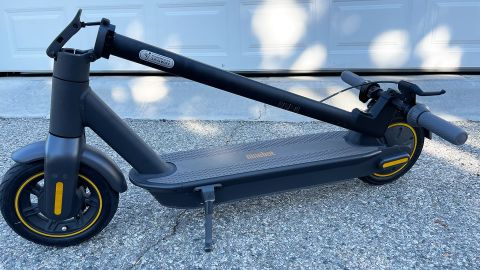
Electric scooters can be an efficient and convenient mode of transportation, but only if they work for you and with your lifestyle. Take the time to really think about your travel and commute needs and how you’ll be using it, and you’ll be able to figure out whether a scooter is for you.
Electric scooters really shine in “last mile” applications, filling in part of a commute that isn’t covered by other transportation. They can eliminate time spent walking to the bus stop or train station, waiting around for the next scheduled service, or driving around looking for a parking spot in your car. They’re ideal for supplementing other forms of transportation.
Of course, if you live close enough to where you work or shop, a scooter can take you directly from your front door to your job or errand. An electric scooter can also be a practical choice for those who might otherwise ride a bicycle, but don’t want to arrive at work sweaty and out of breath, and are put off by the expense of an electric bike (or have nowhere to store one). And for short errands that don’t involve too much cargo carrying (since scooters can’t take racks or panniers like bikes). In those cases, though they’re not exactly cheap, electric scooters can easily pay for themselves if they let you avoid spending money on bus or train fare, or fuel and parking costs for your car.
One thing to keep in mind is that scooters with bigger motors and bigger batteries may be able to take you further, but they’re much bulkier and can weigh quite a lot — the heavier models we looked at weigh nearly 50 pounds, making them tough to wrestle onto a bus or train, and inconvenient to store. That extra power, then, can mean diminishing returns, since the additional oomph means they weigh nearly as much as an e-bike, which will typically have far more range, versatility and carrying capacity.
Consider your local climate as well. If you live in a particularly wet or cold part of the country, it might be worth the extra cost or time to stay dry and warm inside a bus, train car or personal vehicle. Even if you’re open to braving the elements, try and choose one with a higher IP rating. This number will indicate how resistant your scooter is to moisture. For example, the IPX4 rating for the Unagi Model One means that it is “resistant to splashes in any direction”, while the sturdier Apollo City Pro gets an IPX6 rating, meaning it “can resist high-pressure, heavy sprays of water.” None of the scooters we looked at were rated for immersion, so you’ll want to take care.
The most important feature to consider when choosing an electric scooter is probably range. Your scooter won’t be much use if it doesn’t have the battery capacity to get you where you need to go (and back home if you’re not going to be charging it in the meantime). This gets a little tricky because the actual range is going to be different depending on rider weight, any inclines or hills on your route, your speed, and even the outside temperature. It’s important to know that the advertised range from the manufacturer is based on ideal conditions (low rider weight, perfectly flat and smooth ground, low speed, etc.), so I’d recommend cutting the stated range in half to get a more accurate number.
I’d also recommend only purchasing a scooter that complies with UL (Underwriters Laboratories) standards. The lithium-ion batteries inside electric scooters can catch fire and explode while charging, and a UL certification will ensure that you’re not bringing an untested or unreliable battery into your home. All of the scooters in our testing pool are UL listed.
Pneumatic tires — with inner tubes, like bicycle tires — are another feature we recommend, since they soak up the shock of rough surfaces, bumps and cracks, providing better handling and a more comfortable ride. Some cheaper scooters are sold with solid rubber tires that may be puncture proof, but give you a much less comfortable ride,
If you want to ensure you’re getting to your destination as fast as possible, look at the maximum speed offered by each unit. Lighter-duty scooters top out at about 15-20mph, while beefier models can reach up to 35 MPH. Most scooters let you select a top speed limit, so you can choose to stick to lower speeds if you like.
Yes, but the specifics of exactly where you can and cannot ride your scooter will depend on the specific rules and regulations in your area. They’re not quite a moped, but also not really a bicycle, so it will require a little research to figure out exactly how you’re supposed to ride your scooter in a way that’s both legal, and safe for you and other drivers. Some states haven’t made it clear, while others have adopted rules similar to those governing electric bicycle use.
For example, the California DMV states that, “You can only drive motorized scooters on a bicycle path, trail, or bikeway, not on a sidewalk, and you cannot exceed a speed of 15 mph.” They also must stick to the right-hand curb, so they’re not allowed in a left-hand turn lane at a stoplight for example. In this case, you’d need to dismount and use the crosswalk like a pedestrian before entering the bike lane again. They also must stick to roads with a speed limit no greater than 25MPH.
In our experience, this is solid advice regardless of what the law might prescribe. As a general rule of thumb, we’d recommend sticking to quieter side streets and neighborhoods, avoiding busier thoroughfares and intersections with cars traveling at high speeds, and using multiuse paths where available (and where e-scooter use is allowed).
Regardless of the city you’re in, and contrary to what you’ve probably seen, you shouldn’t ride your electric scooter on the sidewalk. Not only is it dangerous to pedestrians–especially if they walk out of a doorway into the scooters path–there are also obstacles and debris that can cause you to lose your balance. If the sidewalk is your only safe means of travel, dismount your scooter and walk it down the sidewalk.
They might look like toys, but electric scooters can be just as dangerous, or more so, than other types of personal transportation. Since widespread adoption of electric scooters only dates back to 2017, there has been little long-term research but some numbers are starting to emerge.
This 2019 study conducted in two Los Angeles emergency rooms found that over the course of a year, 249 patients were admitted with electric scooter related injuries, compared to 195 bicyclists and 181 pedestrian injuries over the same period. While most injuries were minor, forty percent of those electric scooter injuries were head injuries, likely due to the relaxed attitude towards helmet wearing on electric scooters (the study authors write that 94.3% observed scooter riders in their community rode without helmets).
A 2022 UCLA data analysis of injury data since 2014 suggests that the injury rate for electric scooters was 115 per 1 million rides, more comparable to the injury rate for motorcyclists (estimated at 104 injuries per million motorcycle rides) than to the much lower rates for pedestrians and cyclists.
Given these emerging insights and considering the high top speeds achievable by the larger scooters we looked at, we would always recommend wearing a well-fitted helmet when riding a scooter, whether your city requires one or not.
This might sound obvious, but it’s important to actually learn how to properly operate your scooter before hitting the streets, and not just hop right on and hit the accelerator. Make sure to follow any riding instructions or tips in the included user manual, and I’d also recommend taking the time to first get used to riding your scooter in a parking lot or on quiet neighborhood streets. This will help you be aware of riding quirks that you may not otherwise be aware of until you’re traveling at high speeds or in traffic. For example, I quickly noticed in my testing that it was difficult to look over my shoulder without losing my balance, or take a hand off the handlebar to signal or wave at another driver, and I would need to decrease my speed before attempting to do either.
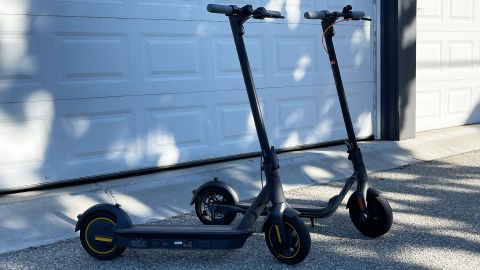
We ran each scooter through a comprehensive testing process to get a clear idea of exactly what makes one model different from another. This made it easy to compare them for rating purposes, as well as accurately explain who they might be best for.
Since the whole point of purchasing an electric scooter is to make your commute more convenient, it’s important that they’re easy to use. Straightforward operation not only makes for a more comfortable and relaxing riding experience, it also increases overall safety. By spending less time and attention manipulating controls and adjusting ride settings, you can fully focus on the road ahead and your surroundings. I judged each scooter on how easy it was to step on and start riding, as well as operate any in-ride functions like blinkers, bells, and speed settings. I also compared each scooter’s charging function, noting types of plugs required, and any frustrating issues like a lack of real-time battery level during charging.
Then, to establish and compare actual battery range, I drove each scooter on the same pre-set route—which included a large hill section and several different surface types—until the battery was completely exhausted. I then timed how long it took to charge that depleted battery back to 100%. (These two metrics are essential for determining if your scooter can both handle the length of your commute, and charge quickly enough to get you back home at the end of the workday.) I also used these rides to judge each scooter’s top speeds as well as overall power, paying attention to how easily the scooter maintained its speed when ascending the hill, or if it struggled and slowed down significantly.
I also compared each scooter’s controls while riding, focusing on how comfortable and responsive the throttle and brake systems were, as well as additional features like directional blinkers and headlights. To evaluate how convenient each scooter was to store when not in use, I folded up and carried each model up and down a flight of stairs. I noted any issues with overall comfort and weight, as well as the security of the hinge and locking mechanism used.
I also judged the overall build quality and construction of each scooter, noting how well-built the larger components seemed to be, and inspecting smaller elements like throttles, bells, kickstands, and brake handles. I looked to ensure that all these elements were sturdy and solid, and noted if any felt flimsy or cheap.
With minimal exposed cabling and a handlebar uncluttered by a bell or mechanical handbrake, it’s easy to appreciate the sleek, streamlined design of the Unagi Model One. This stripped-down design not only looks good, but also makes it an extremely easy to use machine. Unfortunately, the Unagi is best suited to smooth surfaces and short rides, as the solid tires and lack of any suspension makes for a bumpy and uncomfortable ride over rough pavement or asphalt surfaces. I felt every crack and bump as I rode. Also, the 9 mile range was the shortest of all the scooters in our testing. It was the easiest to fold and carry, however — the Unagi Model One folds down and locks into place without having to deal with any extra latches or hooks, and its light weight — just 26.5 pounds — made it the most comfortable option to carry around. So if you just want something sleek and small for a short ride to public transportation, the Unagi might be the ticket.
It doesn’t have the sleek, high-end design of more expensive scooters, but the Swagtron 5 Boost is still capable of zipping you around easily, and a total bargain at its current price. It does have some overall design drawbacks though, as well as operational issues. Its handlebar grips were not only difficult to line up and screw on during assembly, but I also found them easy to accidentally unscrew while riding, a potential safety issue. The display was also inconvenient to read, using dark blue digits on a black background. The throttle and brake controls didn’t have the smooth, controlled feel of other models I tested. Its solid tires, similar to the Unagi Model One’s, also made for a very bumpy ride. All that being said, the low price could still make this scooter a reasonable choice for the rider on a tight budget.
If security is a priority, you’ll appreciate the two lock options — a digital code that stops the motor from operating and a physical combination lock — provided with the GoTrax G4. The wide display is also really easy to read, and when the scooter is stopped, the speedometer reverts to an odometer, making it easy to see how far along you are on your trip. The 11.8 mile range was relatively low however, and the black control buttons weren’t very convenient to make out while riding. My favorite feature of the GoTrax G4 is its heavy-duty latch system that keeps the frame locked into place when folded down. On some other large scooters — such as the Apollo City Pro — a slicker looking but flimsier, less secure latch is used. On the GoTrax, the bright red clip and fender hook are made with thick metal instead of plastic, giving the entire until a very solid, heavy-duty feel and look which worked great
Although it had the same solid feel, straightforward controls and easy to use mobile app as the other Segway models I tested, at 48.5 pounds the F65 is ultimately just too heavy to carry around on a daily commute, especially if you need to navigate a flight of stairs, lug it onto a train or bus, or the like. It does feature directional blinkers though, which makes it a great option for city and nighttime riders, and their controls were easy to turn on and off with a thumb switch. Its 700W max motor allowed me to easily climb inclines during my testing, and the impressive range — 22.5 miles — was the second longest of all the scooters we tested (only the Apollo City Pro gave us more mileage). If you don’t plan on folding and carrying this scooter, and long range is a priority, the Segway Ninebot F65 could work, but at its weight you might want to consider an e-bike (if it fits your budget).
It won’t be a practical choice for those who prefer a light-weight, sleek-looking option, but if you want a scooter that can go extremely fast and travel extremely far, the Apollo City Pro could be a great choice. Its twin 500W motors allowed me to easily hit 26 MPH, and a more adventurous rider could adjust the max speed up to 32MPH. I was most impressed with the range of this scooter, and was able to travel for 25 miles before exhausting the battery. With front and rear suspension, the Apollo City provided the most comfortable, bump-free ride, and combined with the wide 10-inch pneumatic tires, allowed it to roll over large cracks and divots that lighter-duty scooters would be unable to handle. My biggest takeaways from testing the Apollo City Pro was its heavy weight — 65 pounds is far too heavy to carry around comfortably — and the poorly designed hook system used to lock the frame in place after folding. This hook easily falls out of place when the scooter is set down, which is frustrating as well as a potential safety risk. The buggy, frustrating mobile app was a big drawback as well.
The only non-foldable option I tested, the rental-only Lime Gen4 is noticeably sturdier feeling than the folders, and has a low center of gravity that made for a surprisingly comfortable ride. It also featured angled handlebars that swept back, similar to a bicycle, unlike the straight bars of all my other scooters. This made the Lime G4 more comfortable to ride for long periods of time, and easier to maintain control and balance. I noticed that I was also able to briefly take one hand off the handlebar when I needed to signal other cars or scratch my nose, something I had difficulty doing when using straight handlebars. It was inconvenient to track down an available scooter though, not to mention find one that had enough battery to bring me to my destination. I was also surprised by the cost of a Lime scooter. My first ride, with a base fare of $3.50, ended up costing me $19.10 for a 4.9 mile/26 minute ride. If that was half of my commute, I’d be spending $191 per workweek, which is not ideal — clearly making the argument for scooter ownership.





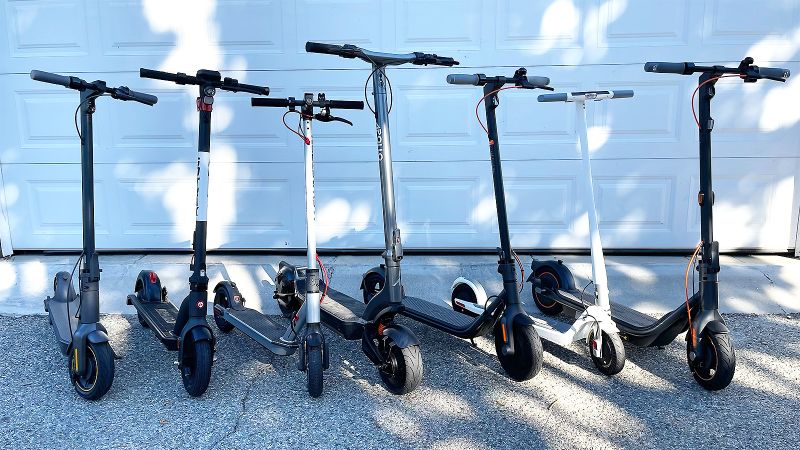
More News
Columbia’s University Senate Calls for an Investigation Into the Administration
Opinion | The Student-Led Protests Aren’t Perfect. That Doesn’t Mean They’re Not Right.
5 Takeaways From the Second Week of Donald J. Trump’s Criminal Trial